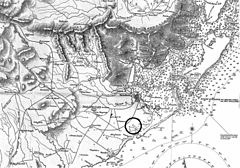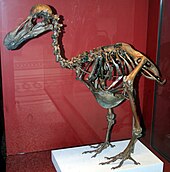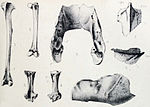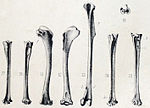| Mare aux Songes | |
|---|---|
| Stratigraphic range: Holocene | |
| Type | Geological formation |
| Location | |
| Region | Africa |
| Country | Mauritius |
 Mare aux Songes encircled on a map of the Mauritian railway system in 1866 | |
The Mare aux Songes (English: "sea of taro"; French: [ma.ʁ‿o sɔ̃ʒ]) swamp is a lagerstätte located close to the sea in south eastern Mauritius. Many subfossils of recently extinct animals have accumulated in the swamp, which was once a lake, and some of the first subfossil remains of dodos were found there.
History
In 1865, a British railway engineer working in south-east Mauritius noticed bones that had been disturbed by workers digging peat. He showed his findings to the government schoolmaster at Mahébourg, George Clark, who subsequently uncovered an abundance of subfossil dodo bones in the swamp. Clark had been searching for thirty years, having been inspired by Strickland & Melville's monograph about the bird. In 1866, Clark explained his procedure to The Ibis, an ornithology journal:
After many fruitless visits to the spot... I resolved by sending some men into the centre of the marsh, where the water was about three feet deep and there, by feeling in the mud with their naked feet, they met with one entire tibia, a portion of another, and a tarso-metatarsus. The Dodo bones were imbedded only in the mud at the bottom of the water in the deepest part of the marsh... Encouraged by success, I employed several hands to search in the manner described, but I met with but few specimens of dodo bones till I thought of cutting away a mass of floating herbage nearly two feet in thickness, which covered the deepest part of the marsh. In the mud under this, I was rewarded by finding bones of many dodos.

Remains of over 300 dodos were found in the swamp, but only very few skull and wing bones among them, which may be explained by the upper bodies having been washed away or scavenged while the lower body was trapped, which is similar to the way many moa remains have been found in New Zealand marshes. In 1889, Théodor Sauzier was commissioned to find more dodo remains in the Mare aux Songes. He was successful, and also found remains of other extinct species. Twenty-six museums worldwide have significant holdings of dodo material, almost all found in the Mare aux Songes.
In October 2005, after a hundred years of neglect, a part of the Mare aux Songes swamp was excavated by an international team of researchers. To prevent Malaria, the British had covered the swamp in hard core during their rule over Mauritius, which had to be removed. Many remains were found, including bones of dodos in various stages of maturity, and several bones obviously from the skeleton of one individual dodo, which have been preserved in their natural position. These findings were made public in December 2005 in the Naturalis museum in Leiden. Of the fossils found in the swamp, 63% belonged to turtles of the extinct genus Cylindraspis, and 7.1% belonged to dodos, which had been deposited within several centuries, 4000 years ago. Subsequent excavations suggested that dodos, along with other animals, became mired in the Mare aux Songes while trying to reach water during a long period of severe drought about 4,200 years ago.
Paleofauna
| This section needs expansion. You can help by adding to it. (June 2013) |
The following animals have been identified from fossils in the Mare aux Songes.
Birds
| Birds reported from the Mare aux Songes | ||||||
|---|---|---|---|---|---|---|
| Species | Authority | Common name | Family | Material | IUCN status | Images |
|
Red rail |
Mandibles, tibiotarsi |
Extinct |
   | ||
|
Mascarene coot |
Hip and leg bones |
Extinct | |||
|
Réunion harrier |
Tarsometatarsi, tibiae and metacarpals |
Locally extinct | |||
|
Broad-billed parrot |
Skulls, mandibles, sternum, furcula, coracoids, humeri, ulnae, femora, tibiotarsi, carpometacarpus |
Extinct | |||
|
Mascarene grey parakeet |
Palatines |
Extinct | |||
|
Dodo |
All skeletal elements known from the swamp |
Extinct | |||
|
Mauritius blue pigeon |
Tarsometatarsus |
Extinct | |||
|
Pink pigeon |
Tarsometatarsus |
Endangered | |||
|
Mauritius owl |
Humerus, tibia, tarsus, unguals |
Extinct | ||||
|
Greater flamingo |
Tarsometatarsus |
Locally extinct | |||
Reptiles
| Reptiles reported from the Mare aux Songes | ||||||
|---|---|---|---|---|---|---|
| Species | Authority | Common name | Family | Material | IUCN status | Images |
|
Saddle-backed Mauritius giant tortoise |
Skulls, carapaces |
Extinct |
  | ||
|
Domed Mauritius giant tortoise |
Skulls, carapaces |
Extinct | |||
|
Orange-spotted day gecko |
Humerus |
Endangered | |||
|
Mauritian giant skink |
Mandibles, vertebrae |
Extinct | |||
|
Round Island skink |
Humerus |
Vulnerable | |||
|
Hoffstetter's worm snake |
Seven trunk vertebrae |
Extinct | |||
Mammals
| Mammals reported from the Mare aux Songes | ||||||
|---|---|---|---|---|---|---|
| Species | Authority | Common name | Family | Material | IUCN status | Images |
|
Mauritian flying fox |
Mandible |
Endangered |
  | ||
|
Small Mauritian flying fox |
Mandible |
Extinct | |||
|
Natal free-tailed bat |
Phalanges |
Vulnerable | |||
|
Mauritian tomb bat |
Phalanges |
Least concern | |||
References
- ^ Parker, Ian (14 January 2007). "Digging for Dodos". New Yorker. Retrieved 3 July 2023.
- Hume, J. P. (2006). "The History of the Dodo Raphus cucullatus and the Penguin of Mauritius" (PDF). Historical Biology. 18 (2): 69–93. CiteSeerX 10.1.1.695.6929. doi:10.1080/08912960600639400. ISSN 0891-2963. S2CID 2954728.
- Clark, G. (April 1866). "Account of the late Discovery of Dodos' Remains in the Island of Mauritius". Ibis. 8 (2): 141–146. doi:10.1111/j.1474-919X.1866.tb06082.x.
- ^ Hume, Julian Pender (2005). "Contrasting taphofacies in ocean island settings: the fossil record of Mascarene vertebrates". Proceedings of the International Symposium "Insular Vertebrate Evolution: The Palaeontological Approach". Monografies de la Societat d'Història Natural de les Balears. 12: 129–144.
- Newton, E.; Gadow, H. (1893). "IX. On additional bones of the Dodo and other extinct birds of Mauritius obtained by Mr. Theodore Sauzier". The Transactions of the Zoological Society of London. 13 (7): 281–302. doi:10.1111/j.1469-7998.1893.tb00001.x.
- Fuller, Errol (2002). Dodo – From Extinction To Icon. London: HarperCollins. ISBN 978-0-00-714572-0.
- Cheke, Anthony S.; Hume, Julian Pender (2008). Lost Land of the Dodo: an Ecological History of Mauritius, Réunion & Rodrigues. T. & A. D. Poyser. p. . ISBN 978-0-7136-6544-4.
- ^ Rijsdijk, K. F.; Hume, J. P.; Bunnik, F.; Florens, F. B. V.; Baider, C.; Shapiro, B.; van der Plicht, H.; Janoo, A.; et al. (January 2009). "Mid-Holocene vertebrate bone Concentration-Lagerstätte on oceanic island Mauritius provides a window into the ecosystem of the dodo (Raphus cucullatus)" (PDF). Quaternary Science Reviews. 28 (1–2): 14–24. Bibcode:2009QSRv...28...14R. doi:10.1016/j.quascirev.2008.09.018. hdl:11370/bf8f6218-1f85-4100-8a90-02e5e70a89b6.
- Rijsdijk, K. F.; Zinke, J.; de Louw, P. G. B.; Hume, J. P.; Van Der Plicht, H.; Hooghiemstra, H.; Meijer, H. J. M.; Vonhof, H. B.; et al. (2011). "Mid-Holocene (4200 kyr BP) mass mortalities in Mauritius (Mascarenes): Insular vertebrates resilient to climatic extremes but vulnerable to human impact". The Holocene. 21 (8): 1179–1194. Bibcode:2011Holoc..21.1179R. doi:10.1177/0959683611405236. S2CID 85845297.
- Hume, J. P. (2007). "Reappraisal of the parrots (Aves: Psittacidae) from the Mascarene Islands, with comments on their ecology, morphology, and affinities" (PDF). Zootaxa. 1513: 4–41. doi:10.11646/zootaxa.1513.1.1.
- Hume, Julian Pender (2011). "Systematics, morphology, and ecology of pigeons and doves (Aves: Columbidae) of the Mascarene Islands, with three new species". Zootaxa. 3124: 28–39. doi:10.11646/zootaxa.3124.1.1. ISBN 978-1-86977-825-5.
20°26′49″S 57°41′46″E / 20.447°S 57.696°E / -20.447; 57.696
Categories: